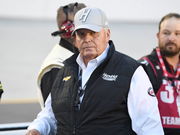
Imago
Holly Cain / NASCAR Wire Service

Imago
Holly Cain / NASCAR Wire Service
For more than a decade, NASCAR’s playoff system has sparked debate among fans and drivers alike. The elimination format, launched in 2014, reshaped championship battles by putting greater weight on late-season performance. Since then, drivers have had to adapt to the sprint-like nature of the final 10 weeks, where the role of stage points has become critical in securing advancement. Now, with the 2025 Cup Series Playoffs set to begin, veterans who have experienced the system’s growing pains face the challenge differently than rookies. Among them, Chase Elliott enters this year’s postseason in the seventh seed, chasing a second title.
Watch What’s Trending Now!
After a steady regular season that included his 20th career win at Atlanta, Elliott secured his playoff spot. While his campaign hasn’t matched the dominance of Hendrick Motorsports teammates William Byron or Kyle Larson, Elliott’s consistency keeps him competitive. This is reflected in one of the best average finishes in the field. But what matters most isn’t the win column; it’s how drivers apply their playoff experience when the stakes are highest. Elliott has been outspoken about the value of lessons learned, navigating the format over the years. Ahead of the playoffs, he’s shared insights into his current competitive edge.
ADVERTISEMENT
No substitute for experience for Chase Elliott
Asked how the playoff format affects younger drivers, Chase Elliott admitted he never really thought about it that way at first. Instead, he reflected on his own early seasons. “I remember those first couple years. I don’t think people realized how valuable the stage points were… No one really kinda knew how to balance that,” Elliott said. During his rookie playoff run in 2016, stage racing was still a new concept, and many teams underestimated how pivotal those points would be for postseason survival. Now, as Elliott pointed out, the strategy has “kinda normalized,” with even fans subconsciously picking up lessons while watching the races. His insight highlights how hard-earned experience sharpens a driver’s playoff edge.
That edge only grows sharper when accumulated over multiple championship runs. “Just having the experience in general, regardless of what the result was in the year before, I think experience, both good and bad, can be helpful,” Elliott explained. As the 2020 Cup Series champion, Elliott has experienced both deep playoff campaigns and early exits. His continued partnership with crew chief Alan Gustafson has built a foundation of trust crucial for navigating NASCAR’s unforgiving playoff structure, which resets points every three races and eliminates drivers until only four remain. Elliott’s accumulated knowledge helps him anticipate the delicate balance between aggression and survival required to advance.
.@chaseelliott is one of the most expensive veterans now in the 2025 Cup Playoffs, and says living through these 10 weeks is worth dividends. #NASCAR pic.twitter.com/X6Iwz0GC6R
— Peter Stratta (@peterstratta) August 27, 2025
ADVERTISEMENT
Looking ahead, Elliott faces a playoff grid without a clear favorite. Byron and Larson bring multiple wins, while veterans like Denny Hamlin and Joey Logano carry their own postseason pedigree. Elliott’s advantage lies in applying what he calls the “helpful” lessons of past highs and lows to each elimination round. Whether that translates into a second title will depend on execution at critical moments, but one thing is certain. Elliott has transformed his playoff education into the very edge he believes could propel him back to the top of the sport.
Top Stories
Kyle Busch’s Future in Limbo As Richard Childress Admits Exit Plans Amid NASCAR on Sale Rumors

Charter Lawsuit Updates: Rick Hendrick’s ‘Rejected’ Email Plea Unveils Dark Side of NASCAR Operations

NASCAR Behind Kurt Busch’s Retirement? Truth Comes to Light In Court After Michael Jordan’s Warning

Richard Childress Echoes Heather Gibbs’ ‘Gun to the Head’ Claims as He Exposes NASCAR’s Charter Negotiations

“He Wanted to Ki** Me”: Kyle Larson Recalls Terrifying Moment When Veteran Rival’s Crew Stormed Him After Trash Talk

ADVERTISEMENT
Elliott credits Earnhardt Jr. and King Petty for the No. 9 switch
Chase Elliott’s rise in NASCAR is closely tied to the No. 9, a number steeped in family history and racing tradition. He started his Cup career in the No. 25 car and later took over Jeff Gordon’s iconic No. 24. But it was a major team reshuffle in 2018 that set Elliott on the path back to the No. 9—a number that has deep meaning both for him and the sport.
Elliott revealed that Dale Earnhardt Jr. encouraged him to push for the No. 9 during that restructuring. This wasn’t just a strategic move; it was a nod to family legacy. The No. 9 was made famous by his father, Bill Elliott, and reclaiming it symbolized the continuation of that legacy on track.
That nudge led Elliott to approach team owner Rick Hendrick with the idea. From there, Petty Enterprises granted the No. 9 to Elliott. As he fondly put it, the “King let us have it,” recognizing his family’s connection to the number. That switch was everything but arbitrary. The No. 9 carries deep roots for the Elliots. Bill Elliott raced to his 1988 Cup championship and 38 victories under that number. Chase had long felt tied to it, driving No. 9 in go-karts, late models, and winning the 2014 Xfinity title with it.
ADVERTISEMENT
This decision transcended branding. It was a symbolic passing of the torch. By securing the No. 9, Chase Elliott wasn’t just carrying a number. He was sustaining a family heritage enriched by support from two NASCAR icons. And with that legacy in place, he’s not merely racing. He’s preserving and advancing the Elliott name in stock-car history.
ADVERTISEMENT
ADVERTISEMENT
ADVERTISEMENT

